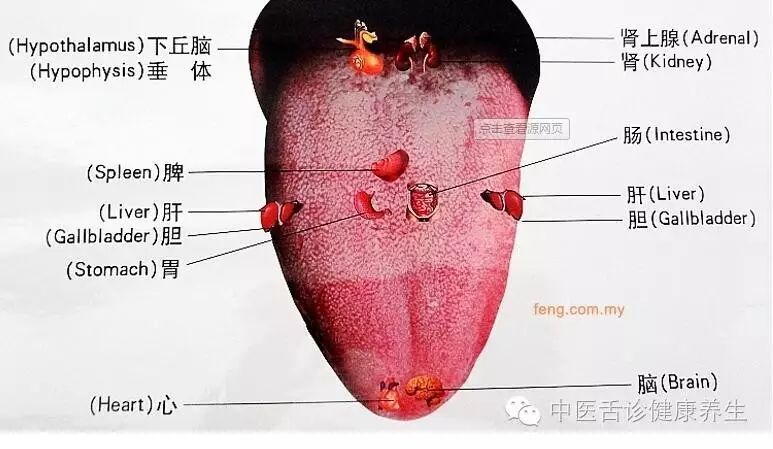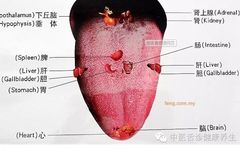Tongue diagnosis is an important aspect of Traditional Chinese Medicine (TCM) for diagnosing diseases. The depth and breadth of observing the tongue body and coating surpasses the current understanding of tongue diagnosis in Western medicine. Through tongue diagnosis, TCM can understand the balance of the body’s organs, discern the depth of pathogenic factors, assess the cold-heat nature of the condition, and evaluate the severity of the illness.
In TCM, to observe the tongue’s appearance more thoroughly, the five zang organs are allocated to different parts of the tongue. The commonly used parts are: the tip of the tongue corresponds to the Heart and Lung, the center of the tongue corresponds to the Spleen and Stomach, and the sides of the tongue correspond to the Liver and Gallbladder.

Observation of Tongue Coating
(1) Observation of tongue coating: The tongue coating refers to a thin layer of substance covering the surface of the tongue, which can be used to identify the strength of the stomach qi (digestive function), reflect the depth and nature of pathogenic factors, and indicate changes in the digestive system. The formation of tongue coating is normally due to the stomach qi; thus, a healthy person’s tongue coating is often thin, white, and moist. In pathological conditions, the tongue coating is mainly influenced by pathogenic factors. The observation of tongue coating focuses on the quality and color of the coating.
⑴ Quality of coating: This includes the presence or absence, thickness, dryness, slipperiness, and stickiness of the coating.
① Presence or absence: This can indicate the strength or weakness of the righteous qi and the progression of the disease. A coating indicates that the patient’s stomach qi is still present, and the body has some resistance to disease; absence of coating indicates insufficient righteous qi and low resistance, which can be seen in the later stages of febrile diseases with yin fluid deficiency.
② Thickness: This can infer the strength or weakness of pathogenic factors and the depth of the condition. A thin coating often indicates normalcy or that the pathogenic factor is superficial, suggesting a mild condition; a thick coating indicates a strong pathogenic factor that has penetrated deeper, which may also be accompanied by symptoms such as indigestion, upper abdominal distension, foul belching, and nausea. If the coating changes from thin to thick, it often indicates that the pathogenic factor has moved from the exterior to the interior, with the disease worsening; if the coating changes from thick to thin, it indicates that the pathogenic factor is retreating and the righteous qi is recovering, suggesting improvement in the condition.
③ Dryness and slipperiness: This can indicate the presence or absence of body fluids and infer the nature of the pathogenic factor. A dry coating is often seen in febrile diseases with high fever, where heat injures body fluids, accompanied by dry mouth and thirst; a dry coating can also be seen in yin deficiency. A slippery coating (excess moisture on the coating) is often seen in cold or damp conditions.
④ Stickiness and rot: This can infer the presence of phlegm-dampness or food stagnation. Stickiness refers to a coating that is fine, dense, medium-thick at the center and thin at the edges, smooth, and cannot be scraped off easily; a white sticky coating indicates cold-dampness, while a yellow sticky coating indicates damp-heat. A rotten coating resembles decayed matter, coarse, loose, and easily scraped off, often indicating food accumulation or phlegm turbidity.
⑵ Color of coating: The main colors are white, yellow, gray, and black.
① White coating: Indicates exterior conditions and cold conditions, often with a milder disease. If the coating is thin, white, and moist, accompanied by chills, fever, and body aches, it is often due to an external wind-cold invasion; if the coating is white, slippery, and accompanied by chest tightness, nausea, and excessive phlegm, it indicates internal phlegm-dampness; a white coating with a hint of yellow, accompanied by alternating chills and fever, bitter mouth, and dry throat, indicates a half-exterior, half-interior condition; a thin white coating with a slight yellow tint can also be seen in wind-heat invasions.
② Yellow coating: Generally indicates interior conditions and heat conditions. A thin yellow coating that is slightly dry indicates an external wind-heat invasion; a thick, dry yellow coating often indicates internal heat or excess heat; a dry, cracked yellow coating with prickles, accompanied by abdominal fullness and constipation, indicates dryness-heat injuring body fluids; if the coating is yellow, slippery, and sticky, it often indicates damp-heat accumulation.
③ Gray coating: Often indicates interior conditions, with distinctions between cold and heat. A slippery gray coating indicates deficiency-cold or cold-dampness; a dry gray coating often indicates excess heat injuring body fluids.
④ Black coating: Often indicates severe conditions, primarily indicating excess cold or extreme heat. A slippery black coating, with a cold body and cold limbs, often indicates yang deficiency or internal cold; a dry, cracked tongue coating often indicates extreme heat or yin injury.
From the above, it can be seen that TCM can infer the nature and evolution of diseases through the observation of tongue coating, such as the color of the coating changing from white → yellow → gray → black; the quality of the coating changing from moist → dry → scorched → cracked, thin → thick, present → absent, which often indicates that the pathogenic factor has moved from the exterior to the interior, and the condition has worsened. If the tongue coating evolves in the opposite direction, it often indicates improvement in the condition or recovery of the righteous qi. However, when observing the tongue coating, one should be cautious to distinguish false coatings or stained coatings: infants in the breastfeeding period often have a white, slippery coating, while smokers often have a yellow, sticky coating; consuming loquats, riboflavin, adenosine, and certain yellow medications, such as Huanglian (Coptis chinensis) and Zhizi (Gardenia jasminoides), can cause the tongue coating to turn yellow; consuming olives, pickled vegetables, and sauerkraut can cause the tongue coating to turn black, which should not be considered pathological coatings.
Observation of Tongue Body
(2) Observation of tongue body: This involves examining the essence of the tongue, including its color and body state (shape, dynamics). TCM often uses this to identify the strength or weakness of the organ qi (righteous qi), changes in qi and blood, and the severity of the condition.
A normal tongue body should be light red (neither too pale nor too deep), moist (neither dry nor overly wet), with a proper shape and flexible movement.
⑴ Observation of tongue color: The main tongue colors are pale white, red, deep red (dark red), and purple.
① Pale white (lighter than normal tongue color): Often seen in deficiency conditions and cold conditions. A pale white, tender, and smooth tongue color often indicates yang deficiency or insufficient qi and blood (spleen yang deficiency may be accompanied by poor appetite, abdominal distension, and loose stools; kidney yang deficiency may be accompanied by cold intolerance, cold limbs, facial puffiness, and foot swelling; insufficient qi and blood may be accompanied by shortness of breath, fatigue, and palpitations). If the pale white tongue has a white coating, and is accompanied by poor appetite, thin stools, and upper abdominal pain that prefers warmth and pressure, it indicates spleen-stomach deficiency-cold; if accompanied by a pale mouth, abdominal fullness, and heaviness in the limbs, it often indicates cold-dampness obstructing the spleen.
② Red tongue (bright red): Often seen in heat conditions. A red and dry tongue indicates heat injuring body fluids; a bright red tongue with prickles indicates excessive heat; a red tip of the tongue often indicates heart fire; a red edge of the tongue often indicates liver-gallbladder heat.
③ Dark red tongue: Primarily seen in severe internal heat. The appearance of a dark red tongue in external febrile diseases is a sign that the pathogenic factor has entered the nutritive and blood levels, indicating that the external pathogenic factor has moved from the exterior to the interior, with severe internal heat and a serious condition. The appearance of a dark red tongue in internal injuries and miscellaneous diseases indicates yin deficiency with excessive fire, often seen in chronic or severe illnesses.
④ Purple tongue: Often seen in heat conditions, cold conditions, or stasis conditions. A purple-red, dry, and cracked tongue, accompanied by high fever and dehydration, often indicates extreme heat with yin deficiency; a purple, moist tongue often indicates excessive yin-cold or yang deficiency; a tongue with purple spots on the edges often indicates internal organ stasis; a swollen, purple-blue tongue often indicates epidemic toxins or poisoning.
⑵ Observation of tongue body state: This includes examining the tongue’s age (old or young), thickness, extension and retraction, hardness and softness, prickles, cracks, deviation, and tremors.
① Age: A tongue that is firm and old often indicates an excess condition; a tongue that is swollen, tender, and smooth often indicates a deficiency condition.
② Thickness: A swollen tongue body is often related to phlegm, dampness, heat, or toxins; a pale white and swollen tongue often indicates spleen and kidney yang deficiency, and can also be seen in qi and blood deficiency anemia; a pale red and swollen tongue with teeth marks on the edges often indicates spleen dysfunction and phlegm-dampness obstruction; a red, dark, and swollen tongue often indicates excessive heat toxicity, which can be seen in infectious diseases or certain toxicities. A thin, small, and dry tongue often indicates yin and blood deficiency, with excessive fire.
③ Extension and retraction: A tongue that is extended and protrudes beyond the lips is called “protruding tongue”; if the tongue is manipulated outside the lips, it is called “manipulating tongue”, both of which often indicate heat in the heart and spleen, commonly seen in infants; a tongue that is tightly contracted and cannot be extended often indicates a severe condition. A red, dark, and short tongue often indicates phlegm-dampness obstruction.
④ Hardness and softness: A tongue root that is hard, with movement difficulties, unclear speech, or aphasia, is often seen in patients with external diseases, heat entering the pericardium, phlegm turbidity obstruction, or as a precursor to stroke. A soft, retracted tongue that is weak and powerless often indicates extreme deficiency of qi and blood, with loss of nourishment to the tendons and vessels.
⑤ Prickles and cracks: Prickles are the papillae (taste buds) protruding on the tongue; if the tongue body is deep red, it often indicates extreme heat disease with excessive fire; if accompanied by old yellow or black coating, it often indicates severe heat evil; if the tongue surface has cracks, and the tongue body is deep red, it often indicates heat disease with excessive heat injuring yin; if the tongue body is pale white, it often indicates blood deficiency and lack of moisture.
⑥ Deviation and tremors: If the tongue deviates to one side when extended or if one side of the tongue is numb or trembles, it can be seen in stroke; if the tongue extends involuntarily and the tongue body is pale white, it often indicates yang deficiency or deficiency of both qi and blood, and in severe cases, the righteous qi may be exhausted.
Conclusion
The above briefly introduces some knowledge about tongue diagnosis from the perspective of TCM. However, whether this ancient method of tongue diagnosis has scientific validity has raised some doubts. We must provide a clear answer. In recent years, through the integration of TCM and Western medicine in animal experiments, clinical observations, and pathological studies, people have gradually recognized that tongue appearance is closely related to the nature and development of diseases, confirming that tongue diagnosis is one of the reliable methods in TCM diagnosis, and it possesses scientific validity.
Research has shown that various tongue appearances in TCM have certain morphological and pathological bases. Based on studies of tongue appearances in cases of qi deficiency and yin deficiency, researchers have observed tongue appearances in over ten major cases related to qi deficiency and yin deficiency, including endocrine and metabolic disorders. Clinical analysis suggests that the body factors constituting the qi deficiency tongue appearance mainly include blood circulation disorders, digestive dysfunction, endocrine dysfunction, central nervous system dysfunction, and decreased basal metabolism, particularly prevalent during functional decline of the body. In qi deficiency tongue appearances, the formation of pale white tongue color is related to low hemoglobin, capillary changes, and increased filiform papillae. In yin deficiency tongue appearances, tongue dryness may be caused by severe dehydration; tongue redness may be related to malnutrition and vitamin deficiencies; rotten coating, when scraped, and mirror tongue are associated with enzyme and vitamin deficiencies, as well as pancreatic and liver dysfunction. Microscopic examinations of live tongue appearances have revealed that mirror tongue, bright red tongue, black coating, thick sticky coating, and thin white coating not only have different manifestations under the naked eye but also show significant changes histologically, indicating a certain pathological morphological basis. For example, through clinical observations, slit lamp examinations, and various physiological and biochemical measurements, the formation of pale white tongue is mainly related to anemia, protein metabolism disorders, and tissue edema, while endocrine dysfunction, low basal metabolism, and digestive dysfunction are also contributing factors. Yellow coating is often seen in infectious diseases and patients with more digestive system symptoms. Cytological examinations of exfoliated cells have found that yellow coating exudate cells correspond to changes in surrounding blood cells associated with specific infections. In burn patients, if the burn area is large and complicated by sepsis with poor prognosis, the tongue body is often red or dark red. The color of the tongue body, whether red or pale, is closely related to the quantity of red blood cells. Through observations of tongue coating bacterial cultures and quantification, tongue surface temperature, acidity and alkalinity, fluorescence phenomena, microscopic examinations of tongue coating, and pathological biopsies, it has been suggested that the formation of tongue coating is the result of certain bacteria in the normal oral flora proliferating under disease conditions, and the color of the coating is related to the dominant bacterial colonies.
Tongue appearance plays a role in indicating the depth of disease and prognosis. Due to the discovery that yellow coating exudate cells correspond to changes in surrounding blood cells associated with specific infections, the changes in yellow coating exudate cells and surrounding blood cells are similar to the diagnostic role in diseases. Some have summarized that the tongue appearance of liver cancer patients shows blue-purple stripes or irregular spots on both sides, which significantly differ from other malignant tumors and chronic liver diseases, providing a simple indicator for clinical observation of liver cancer. Some institutions have used tongue appearance examinations as a preliminary screening method for early diagnosis of esophageal cancer, where patients with normal tongue color show no lesions, while those with blue or dark purple tongues have been confirmed to have some cases of esophageal cancer, while others may have esophageal epithelial cell hyperplasia, gastric diseases, or pharyngitis.
Tongue appearance has certain value in estimating disease prognosis. A pale white tongue often indicates a chronic process, with a longer disease duration and a higher short-term mortality rate, but few cases recover quickly. Some have estimated the prognosis of hepatitis patients based on changes in tongue coating, finding that after improvement in their condition, most tongue appearances also improve or the coating disappears; if the condition fluctuates, the tongue coating often does not disappear for a long time. It has also been found that in patients with a disease duration of more than six months, the more white, sticky, or thick the coating is, the harder it is to disappear. Such changes in tongue coating can serve as a reference for clinical prognosis estimation. In patients with acute myocardial infarction, the tongue body is often purple, dark red, red, or has ecchymosis and petechiae, with yellow sticky or white sticky coatings being more common. As the condition improves, the sticky coating often changes to a thin coating or less coating, and the tongue body also returns to normal. Therefore, tongue appearance can serve as a reference indicator for differentiating syndromes, assessing the severity of the condition, and evaluating recovery after treatment. These data indicate that the tongue appearances in TCM each have their physiological and pathological basis, and there is a certain relationship between tongue appearance and the nature and development of diseases. However, tongue appearance only reflects one aspect of the body’s physiology and pathology; thus, when analyzing tongue appearance, a holistic view should be maintained, and one should not generalize based on partial observations. It is essential to pay attention to relevant TCM theories and integrate the four diagnostic methods. Additionally, the response of tongue appearance is often variable; for instance, a black coating does not necessarily indicate a severe condition, and yellow or white coatings do not necessarily indicate a mild condition. The changes in tongue appearance should be considered as a local response to the struggle between righteousness and pathogenic factors in the body, and a dialectical comprehensive analysis of the diagnostic data obtained is more in line with objective reality.


